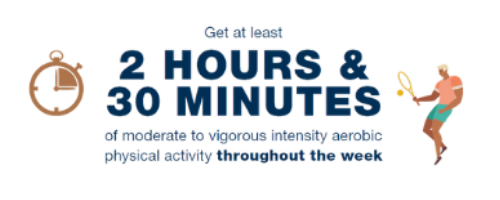Move more
What is physical activity?
Physical activity is using energy to move the body. It includes exercise, which is planned and structured for the purpose of improving fitness, and any movement or activity in daily life. Physical activity can include walking, dancing, gardening, cleaning, and many other leisure or work activities that make your heart rate and breathing rate increase.
What are the benefits of being physically active?
Being active in combination with healthy eating can help maintain a healthy body weight. The benefits of physical activity, however, extend far beyond what your body looks like.
Physical activity can:
- improve your mental and emotional health by relieving stress, improving your mood, helping you sleep better, and helping you concentrate
- reduce the risk of common diseases like cardiovascular disease, osteoporosis, and diabetes
- improve your self-confidence, enhance intimate relationships, build social connections, and help recover from injury and illness
- help protect against a variety of of cancers
Which can be prevented?
There is strong evidence that physical activity protects against colon, endometrium and post-menopausal breast cancers. Evidence also suggests that physical activity can help prevent bladder, lung, liver, kidney, stomach, and esophagus cancers. Physical activity has also shown to be protective against several other cancers by preventing excess body weight and sedentary behavior.
Physical inactivity is the second biggest contributor to preventable cancer cases in Canada (smoking causes the most cancer cases of all modifiable risk factors). At least 7 out of 10 adults are not active enough and do not meet the Canadian Physical Activity Guidelines. As an example, we can prevent around 450 cancer cases in 2038 if all Manitobans are physically active, starting today.
How does physical activity prevent cancer?
Being active can help reduce the risk of cancer by:
- reducing chronic inflammation [slow, long-term inflammation in the body lasting for several months to years]
- improving immune system function
- maintaining healthy hormone levels, like estrogen and insulin

How much physical activity should I do?
To help protect against cancer and other chronic diseases:
- do at least 2 hours and 30 minutes of moderate to vigorous intensity aerobic physical activity throughout the week or
- do at least 1 hour and 15 minutes of vigorous intensity aerobic physical activity throughout the week or
- do an equivalent combination of moderate and vigorous intensity physical activity
Aerobic activity is a form of steady exercise like running, walking, swimming, biking, etc. and should be done for at least 10 minutes. More exercise is usually better for health benefits.
How can I fit physical activity in my life?
Given all the health benefits, why aren’t we more active? People report a lack of confidence in their ability, fear of injury, lack of social support, and lack of motivation and resources as barriers to being physically active. Cold weather conditions, costly gym memberships, and lack of time are some of the most common barriers for Manitobans to incorporate more physical activity into their life. On really busy days, it can even seem impossible to go for a quick walk. It is important to understand that even a small amount of physical activity is good for your physical and mental health. Here are some ways to fit physical activity into your daily routine.
- start with short and easy activities and gradually increase your physical activity
- try active transportation to get from one place to another; this can include walking, biking, skating, skateboarding, rollerblading, jogging, or cross-country skiing
- use the stairs instead of an elevator or escalator
- park a little farther away from your destination
- if you take a bus, get off one bus stop earlier
- walk and talk for casual meetings at work
- plan active social activities with your friends and family
- join an activity club or sign up for an exercise class, such as zumba or yoga
- find inexpensive community-based activity groups in your neighbourhood
- choose activities that are compatible with your age, fitness level, and health status
Focus on your achievements and find healthy ways to reward yourself for small wins. This will boost your confidence and help you increase your physical activity.
Here are some more resources to help you be physically active.

Programs and Services
Winnipeg RHA: Physical Activity Essentials
NorWest Co-op (Winnipeg): Hans Kai
Interlake-Eastern RHA: Physical Activity
Get Better Together (Manitoba)
Manitoba Health: Active Living
ParticipACTION: Excercise videos
Government of Canada: “Physical activity and your health”
Government of Manitoba: Manitoba Parks
Winnipeg in Motion: Resources to help you be active
Manitoba in Motion: Walking, the Activity of a Lifetime
City of Winnipeg: Leisure Guide
City of Winnipeg: Recreation and Leisure
City of Winnipeg: Parks and Open Space
Canadian Society for Exercise Physiology: Canadian Physical Activity Guidelines
Trails:
Check out your local Leisure Centres or Community Centre for free equipment rental.
What is sedentary behaviour?
Sedentary behaviour involves long periods of time without any body movement during waking or non-sleeping hours. It includes activities with prolonged sitting or lying down like driving, watching television, reading, and computer use. Sedentary behaviour uses very little energy and is different from physical inactivity. Being physically inactive means not meeting the specified Canadian Physical Activity Guidelines whereas sedentary behaviour means sitting or lying down for a long period. A person can meet the guidelines but still be considered sedentary if they are spending lots of their day sitting. One out of 10 adults in Canada spend almost 10 hours (approximately 60%) of their waking time sedentary, increasing their chances of developing certain health conditions and a variety of cancers.
What are the benefits of sitting less?
A sedentary lifestyle can increase excess body fat, which could lead to weight gain and obesity.
Moving more and sitting less can decrease your risk for the following health conditions:
- weight gain and obesity
- type 2 diabetes
- osteoporosis
- mental health conditions
- back and neck pain
- heart disease
- high blood pressure
- a variety of cancers
Which cancers can be prevented?
Moving more can help prevent weight gain and obesity, and therefore protect from obesity-related cancers. There is strong evidence that being less sedentary will discourage weight gain and indirectly reduce the risk of colon, breast, and endometrium cancers. As an example, we could prevent around 280 cancer cases in 2038 if all Manitoban adults sit for less than six hours a day, starting today.

How does sitting less prevent cancer?
If you sit more than six hours a day, there may be a negative impact on your health, even if you are meeting all your physical activity goals.x Long periods of sitting can lead to weight gain and obesity, which may allow for the growth of abnormal cells in the body, leading to a variety of cancers. Obesity can cause the growth of abnormal cells by:v
- reducing energy (caloric) burning
- increasing insulin and blood pressure levels
- increasing levels of hormones and chronic inflammation [slow, long-term inflammation in the body lasting for several months to years] in the body
What can you do?
To help protect against cancer and other chronic diseases:
- do not sit for more than six hours each day
- reduce the amount of time you spend in front of a screen
- do at least 2 hours and 30 minutes of moderate-intensity aerobic physical activity (cardio) or 75 minutes of vigorous-intensity aerobic physical activity throughout the week
How can you sit less and move more?
Sitting too much can be a personal choice based on motivation or could also be due to environmental and work-related barriers. Outdoor surroundings, weather, and work requirements such as office-based work and technological advances, could be obstacles to moving more frequently.
By shifting some of the time spent sitting to even a little body movement throughout the day could be beneficial. There are many small changes you can make to sit less and move more:
- challenge yourself to reduce your screen time by setting limits for computer, cell phone, and TV use
- at work, set an alarm for every 30 minutes to stand up and do a few simple stretching exercises, even during meetings
- use a standing desk at work
- minimize inactive screen time or do an activity while using a screen, such as standing or folding laundry
- move around while you are talking on the phone
- try video games that get you moving
- walk to your coworker’s desk to discuss issues instead of emailing or phoning
Take a minute to move whenever and wherever you can.
Here are some more services and resources to help you sit less.
Programs and Services
Winnipeg RHA: Mind and Body Wellness
NorWest Co-op (Winnipeg): Hans Kai
Interlake-Eastern RHA: No Gym Required
Get Better Together (Manitoba)
Active Aging in Manitoba- Take a Minute to Move
Get Encourage Workplace Wellness App
Canadian Cancer Society: Tips to help you sit less
Check out your local Rec Centre or Community Centre for free equipment rental!
EN | FR

